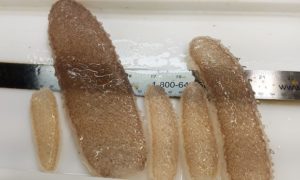Millions of mysterious ‘sea pickles’ swamp US west coast
Huge and unexplained bloom has fishers racing to save their nets, and scientists hurrying to study the rare animal.
By Eleanor Ainge Roy – the guardian

Pyrosome, which have gathered in huge blooms on the west coast of America this month. Photograph: University of Oregon
A rare, tiny marine creature known as the “unicorn of the sea” has swarmed in its millions on the west coast of America, ruining fishermen’s nets and baffling scientists who are scrambling to find out more about them.
Fishers along the west coast have told researchers that in some places they are unable to catch anything because the pyrosome clusters are so dense and tightly packed. Their hooks, when pulled from the ocean, wriggle with the odd-looking creatures, which are sometimes referred to as “sea pickles” or “fire bodies”.
The distinctive animals – which are only a few millimetres long but gather in huge colonies – have washed up on popular beaches, bemusing local residents.
Olivia Blondheim, a graduate student at the University of Oregon who is part of a new research team set up to study the bloom, said: “Right now we are scrambling to learn as much as possible while we have the opportunity.
“If we continue to see this many, what impact will it have on the ecosystems here, and what economic impact on the fisheries? There are so many unknowns at this point, it really is a remarkable bloom.”
Pyrosomes are tubular, gelatinous creatures that are actually moving colonies of tiny organisms. Asexual creatures which reproduce by cloning themselves,, they have long fascinated seafarers, who have been pictured swimming through the middle of pyrosomes up to 30 metres long.
Blondheim said no one knows how much surface area the pyrosome bloom covers, except that they have gathered right along the west coast in mammoth clusters. She said every time she or fisherman had seen them the swarm stretched “as far as the eye can see”.
Usually found in warm, tropical seas far from the coastline, researchers have been astounded by the unexpected influx of pyrosomes along the west coast of America. It began in Oregon and gradually swept north up the coast, with reports of pyrosomes spotted as far north as Sitca, Alaska.
“There were reports of some pyrosomoes in 2014, and a few more in 2015 but this year there has been an unprecedented, insane amount,” says Blondheim.
This summer was the first time she saw a real-life pyrosome in her many years of marine study. Her mentor, Rick Brodeur, a research biologist at the National Oceanic and Atmospheric Administration’s north-west fisheries science center in Oregon, saw his first pyrosome only a couple of years ago, after a 30-year career in marine science.
“On one of our cruises we saw 60,000 in five minutes and they were ripping apart our nets,” said Blondheim. “They were glowing and floating on the surface, completely covering the sea”
Few marine scientists have seen pyrosomes in the flesh because during the day they stay in the depths, sometimes up to 700 metres under the surface and usually in the open sea.
Dr Lisa-ann Gershwin, a marine biology expert, said “gargantuan” blooms of traditionally tropical pyrosomes had occurred in unlikely places before, including in the sub-Antarctic.
“Because they aren’t wanted, and people really aren’t used to seeing them – they really do impact fisheries and catch a lot of attention,” she said. “In the case of these pyrosomes, I don’t think anyone is quite sure what has led to this bloom … it is unusual. There is every possibility it is a natural phenomenon, but an abundance this gobsmackingly big also suggests there may be something behind it that is not natural in origin.”
Gershwin and Blondheim agreed it was worth exploring if the pyrosomes were expanding more quickly due to warming sea temperatures caused by climate change, but other options for the bloom included the animals’ diet changing or unusual sea currents.
“One of the things we are figuring out is have these guys been off the coast and we haven’t seen them? Are they moving inshore for a different reason?” said Blondheim.

